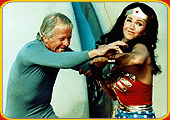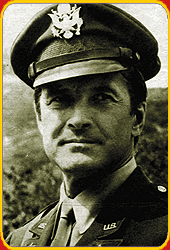  |
 SHE HAD A MAGIC LASSO, AN INVISIBLE PLANE AND WORE THE MOST RIDICULOUS COSTUME IN SUPERHERODOM. HOW COULD YOU FAIL TO LOVE DIANA PRINCE, ASKS JON ABBOTT. SHE HAD A MAGIC LASSO, AN INVISIBLE PLANE AND WORE THE MOST RIDICULOUS COSTUME IN SUPERHERODOM. HOW COULD YOU FAIL TO LOVE DIANA PRINCE, ASKS JON ABBOTT. |
 |
|
"At last, in a world torn by the hatreds and wars of men, appears a woman to whom the problems and feats of men are mere child's play... With a hundred times the agility and strength of our best male athletes and strongest wrestlers, she appears as though from nowhere to avenge an injustice or right a wrong. As lovely as Aphrodite, as wise as Athena, with the speed of Mercury and the strength of Hercules, she is known only as... Wonder Woman!" |
 |
|
With these stirring words, America's first comic book heroine was born, courtesy of editor Max Gaines illustrator Harry Peter and creator Charles Moulton, in All-Star Comics #8 (December 1941). A starring feature in Sensation Comics #1 (January 1942) swiftly followed, but - incredibly mainstream success didn't come until the '70s' when the famous TV show, after several false starts, eventually made it to the TV screen. |
 |
|
Both the comics and the television series played loose with Greek mythology, coming up with a race of Amazon superwomen living on an uncharted Caribbean island to explain away the existence of Wonder Woman. She's actually the immortal Amazon Diana, who leaves her home on Paradise Island to assist humanity in the fight against the Nazis. Her inspiration? Lieutenant Steve Trevor, an American airman who crashes into the sea nearby, and with whom she falls madly in love. Once in the mortal world, she takes on the identity of military secretary Diana Prince, and remains in the US to fight the war (and later every threat imaginable) at Steve's side.
Her crime-fighting kit includes an invisible aeroplane, a magic lariat that compels people to tell the truth, and bullet-repelling bracelets. |
 |
|
The history of the Wonder Woman series on both sides of the Atlantic is, however, rather convoluted. Her first TV appearance was as a member of Super-Friends, a 1973-75 animated series based on the justice League Of America comics, where she was voiced by Shannon Farnon. Later in '73 came the first live action version, with a disastrous Wonder Woman TV movie starring Cathy Lee Crosby. Ricardo Montalban (star of Fantasy Island and, of course, Star Trek's Khan) was the villain, with stocky Kaz Garas as Steve Trevor. The second Wonder Woman pilot - oddly titled The New Original Wonder Woman was vastly superior, and commendably true to the strip's mythology. It boasted a script by former Batman scribe Stanley Ralph Ross, splendid direction by SF veteran Leonard (The Outer Limits) Horn, and a marvellous cast, including Cloris Leachman (camping it up as Queen Hypolyte), Kenneth Mars (recreating his loony Nazi from Brooks' The Producers), Stella Stevens (as a sexy spy), Eric Braeden and Red Buttons, all of whom understood the show's camp style perfectly. |
 |
|
Still blundering around in confusion and indecision, the ABC network ordered only a couple of specials - "Wonder Woman Meets Baroness Van Gunther" and "Fausta, The Nazi Wonder Woman," - and a short run of episodes, which tried to capture the spirit of the original. However, the big break came in 1976 when Lindsay Wagner was injured, thus holding up production on The Bionic Woman. Wonder Woman then became the obvious substitute for the remainder of the season. |
 |
|
Or so you'd think. In fact, Warners was by now so annoyed with ABC's inability to give a firm commitment to the series that it approached CBS with the show, who took it on with the stipulation that the time period she moved up from the '40s to the '70s - the then present. As the comics themselves had moved with the times, this wasn't such a bad move, although it did remove some of the period charm, replacing the zanier '40s milieu with blander adventure scenarios. |
 |
|
Of course, Diana is an immortal - but how do you explain Steve Trevor looking the same in the '70s as he did during World War II? The answer was simple - Diana Prince now worked alongside Steve Trevor's son, who, coincidentally, was a dead ringer for dad, and even had the same name! The two worked for a Washington- based secret agency called the International Agency Defence Command. There was even a cute computer thrown into the mix, a mouthy piece of machinery named IRAC. |
 |
|
In Britain, Wonder Woman's history is just as checkered. The BBC bought it in one of its periodic bids to out-ITV ITV, but then quickly lost its nerve and did its best to bury the show, dumping it out in mid-Summer. This didn't prevent it becoming a huge kiddie hit, however, with plenty of dads also tuning in to ogle over Carter. |
 |
|
Although Time Out implied that the first season had been bought and shelved (this remains unconfirmed), the BBC initially aired only the modern-day episodes, avoiding I references to the WW II scenario. Some time later, though, the excellent WW II-based pilot by Ross and Horn was to turn up on art of a TV movie - and eventually the whole of the series, including the WW II stuff, was broadcast by Sky One, which had inherited the show from BSB. |
 |
 WHO'S
WHO? WHO'S
WHO? |
 |
|
Lynda Carter was already famous as a former Miss USA and Miss World when she secured the role of Wonder Woman, and it was good casting - she was a dead ringer for Charles Moulton's original character, and approached her role with admirable enthusiasm. No great performance was required, and none was given. Carter simply had to look good and be amiable, and she handled it with style. Unlike the pug-faced Hulk and wrinkly Spider-Man, Carter looked striking and authentic in her ludicrous outfit too. With veteran stuntwoman Jeannie Epper providing the action, the most effort demanded of Carter was a toothy grin at the end of each episode. |
 |
|
Lyle Waggoner, once short listed for the role of Batman in the '60s TV series, looked like a model and game show host rolled into one - and he was. Well known for TV variety shows, and with a history of trash TV and film behind him, he treated his role as himbo Steve Trevor with tongue firmly in cheek: "I was really good at being unconscious," he remembers. "I think hitting my head on a rubber rock was half my job." |
 |
 WHERE
ARE THEY NOW? WHERE
ARE THEY NOW? |
 |
|
Post- Wonder Woman, Lynda Carter starred in the short-lived detective series Partners In Crime (aka 50/50) with Loni Anderson sometimes shown off-peak on ITV - and is currently co-starring with Lee Horsley in the series Hawkeye, shown on Sky One, in which she plays pioneer Elizabeth Shields. |
 |
|
Lyle Waggoner is still active in the theatre, turns up occasionally in guest-starring roles on TV, and looks back on Wonder Woman with affection. He has, however, no desire to do another regular TV series. |
 |
|
Wonder Girl Debra Winger - a semi regular on the show, and Diana's kid sister became a film star, of course, and also has fond memories of the show. Apparently, she once made an appearance running around the set of The David Letterman Show in her Wonder Girl costume! |
 |
 FACT
FILE FACT
FILE |
 |
| Regular cast: |
 |
Diana Prince/Wonder Woman: Lynda Carter
Lt. Steve Trevor: Lyle Waggoner |
 |
| Recurring cast: |
 |
General Blankenship: Richard Eastham
Yeoman Etta Candy: Beatrice Colen
Joe Atkinson: Normann Burton
Drusilla/Wonder Girl: Debra Winger |
 |
Executive Producer: Douglas Cramer
Producer: Bruce Lansbury
Developed for television by Stanley Ralph Ross from an original character by Charles Moulton
Music: Artie Kane, Charles Fox |
 |
Total number of episodes: 59 and two pilots
Pilot episode airdate: 7 November 1975
Official series start: 21 April 1976
First UK airdate: 1 July 1978
Last original episode aired: 11 September 1979 |
 |
| UK broadcast history: BBC 1 (second and third seasons only), ITV (first two pilots), Sky One (entire series). |
 |
| Guest stars of interest: Kurt Kasznar (Land Of The Giants), David Hedison (Voyage to the Bottom of the Sea), Ted Shackleford (Space Precinct), Frank Gorshin (Batman), and Rene Auberjonois (Deep Space Nine). |
 |
 A
FEW THINGS YOU PROBABLY DIDN'T KNOW ABOUT... A
FEW THINGS YOU PROBABLY DIDN'T KNOW ABOUT... |
 |
 Lyle Waggoner's earliest screen roles include a bit-part as an android in Lost In Space, and a role in the SF B-movie The Time Travellers. Lyle Waggoner's earliest screen roles include a bit-part as an android in Lost In Space, and a role in the SF B-movie The Time Travellers. |
 |
 All sorts of well known SFTV writers contributed to the Wonder Woman scripts, including Star Trek scribes Dorothy Fontana and Margaret Armen, Buck Rogers writers Anne Collins and Alan Brennert, and former Bewitched scriptwriters (and later Cagney and Lacey creators) Barbara Avedon and Barbara Corday. All sorts of well known SFTV writers contributed to the Wonder Woman scripts, including Star Trek scribes Dorothy Fontana and Margaret Armen, Buck Rogers writers Anne Collins and Alan Brennert, and former Bewitched scriptwriters (and later Cagney and Lacey creators) Barbara Avedon and Barbara Corday. |
 |
 In true Hollywood fashion, while dozens of girls were auditioning for the part of Wonder Woman, Lynda Carter was spotted while screen-testing for something else... In true Hollywood fashion, while dozens of girls were auditioning for the part of Wonder Woman, Lynda Carter was spotted while screen-testing for something else... |
SHE HAD A MAGIC LASSO, AN INVISIBLE PLANE AND WORE THE MOST RIDICULOUS COSTUME IN SUPERHERODOM. HOW COULD YOU FAIL TO LOVE DIANA PRINCE, ASKS JON ABBOTT.
WHO'S WHO?
WHERE ARE THEY NOW?
FACT FILE
A FEW THINGS YOU PROBABLY DIDN'T KNOW ABOUT...
Lyle Waggoner's earliest screen roles include a bit-part as an android in Lost In Space, and a role in the SF B-movie The Time Travellers.
All sorts of well known SFTV writers contributed to the Wonder Woman scripts, including Star Trek scribes Dorothy Fontana and Margaret Armen, Buck Rogers writers Anne Collins and Alan Brennert, and former Bewitched scriptwriters (and later Cagney and Lacey creators) Barbara Avedon and Barbara Corday.
In true Hollywood fashion, while dozens of girls were auditioning for the part of Wonder Woman, Lynda Carter was spotted while screen-testing for something else...